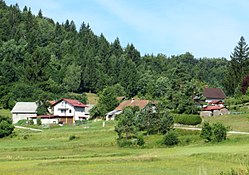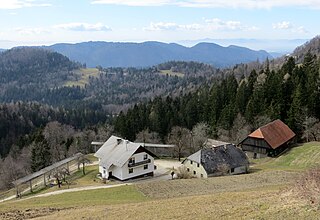
Bela Peč is a small dispersed settlement in the Municipality of Kamnik in the Upper Carniola region of Slovenia.

Bojanja Vas is a village in the Municipality of Metlika in the White Carniola area of southeastern Slovenia, next to the border with Croatia. The entire area is part of the traditional region of Lower Carniola and is now included in the Southeast Slovenia Statistical Region.

Bukovec is a small remote settlement in the hills on the edge of the Municipality of Velike Lašče in Slovenia. Traditionally the area is part of the Lower Carniola region. It is now included in the Central Slovenia Statistical Region.

Lužarji is a small village in the hills southwest of Velike Lašče in central Slovenia. The entire Municipality of Velike Lašče is part of the traditional region of Lower Carniola and is now included in the Central Slovenia Statistical Region.
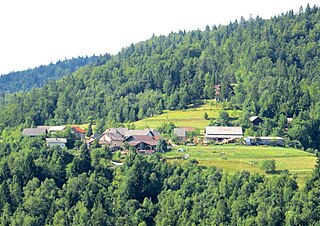
Mački is a small clustered settlement west of Velike Lašče in central Slovenia. The entire Municipality of Velike Lašče is part of the traditional region of Lower Carniola and is now included in the Central Slovenia Statistical Region.
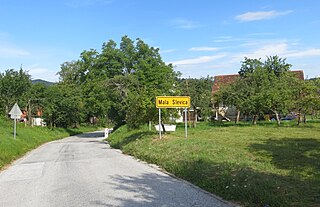
Mala Slevica is a settlement south of Velike Lašče in central Slovenia. The entire Municipality of Velike Lašče is part of the traditional region of Lower Carniola and is now included in the Central Slovenia Statistical Region.

Male Lašče is a village immediately north of Velike Lašče in central Slovenia. The Municipality of Velike Lašče is part of the traditional region of Lower Carniola and is now included in the Central Slovenia Statistical Region.

Mali Ločnik is a settlement north of Turjak in the Municipality of Velike Lašče in central Slovenia. The entire Municipality of Velike Lašče is part of the traditional region of Lower Carniola and is now included in the Central Slovenia Statistical Region.
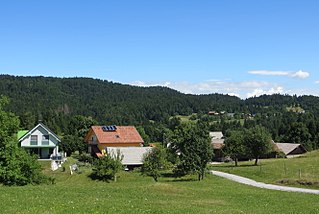
Pečki is a small settlement on the northern side of the road from Rob to Krvava Peč in the Municipality of Velike Lašče in central Slovenia. The entire municipality is part of the traditional region of Lower Carniola and is now included in the Central Slovenia Statistical Region.

Polzelo is a small settlement on a small hill above the Mišja dolina valley southwest of Velike Lašče in central Slovenia. The entire Municipality of Velike Lašče is part of the traditional region of Lower Carniola and is now included in the Central Slovenia Statistical Region.

Rupe is a small remote settlement in the hills south of Rob in the Municipality of Velike Lašče in central Slovenia. The entire municipality is part of the traditional region of Lower Carniola and is now included in the Central Slovenia Statistical Region.

Sekirišče is a small settlement north of the road that leads from Rob to Krvava Peč in the Municipality of Velike Lašče in central Slovenia. The municipality is part of the traditional region of Lower Carniola and is now included in the Central Slovenia Statistical Region.

Selo pri Robu is a settlement on the Rute Plateau in the hills southwest of Rob in the Municipality of Velike Lašče in central Slovenia. The municipality is part of the traditional region of Lower Carniola and is now included in the Central Slovenia Statistical Region.

Srobotnik pri Velikih Laščah is a small village southeast of Velike Lašče in central Slovenia. The entire Municipality of Velike Lašče is part of the traditional region of Lower Carniola and is now included in the Central Slovenia Statistical Region.

Uzmani is a settlement west of Rob in the Municipality of Velike Lašče in central Slovenia. It lies just off the road leading from Rob to Krvava Peč. The entire municipality is part of the traditional region of Lower Carniola and is now included in the Central Slovenia Statistical Region.

Gorenja Brezovica is a village in the Municipality of Brezovica in central Slovenia. The municipality is part of the traditional region of Inner Carniola and is now included in the Central Slovenia Statistical Region.

Rašica is a small village in the hills above Srednje Gameljne north of the capital Ljubljana in central Slovenia. It belongs to the City Municipality of Ljubljana. It was part of the traditional region of Upper Carniola and is now included with the rest of the municipality in the Central Slovenia Statistical Region.
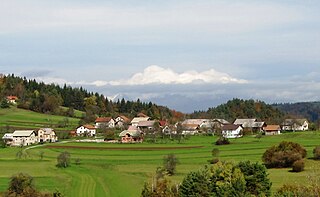
Veliki Lipoglav is a small settlement in the hills southeast of Ljubljana in central Slovenia. It belongs to the City Municipality of Ljubljana and is part of the traditional region of Lower Carniola. It is now included with the rest of the municipality in the Central Slovenia Statistical Region.
